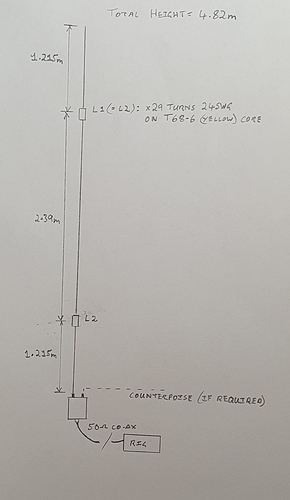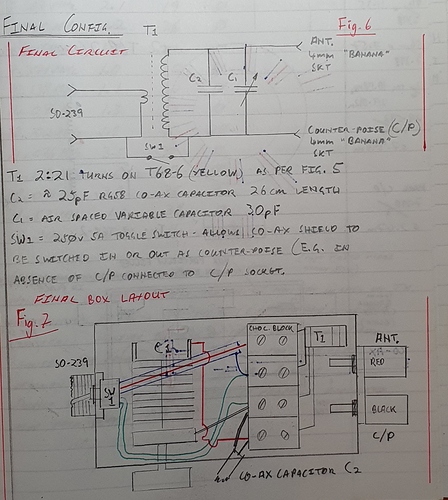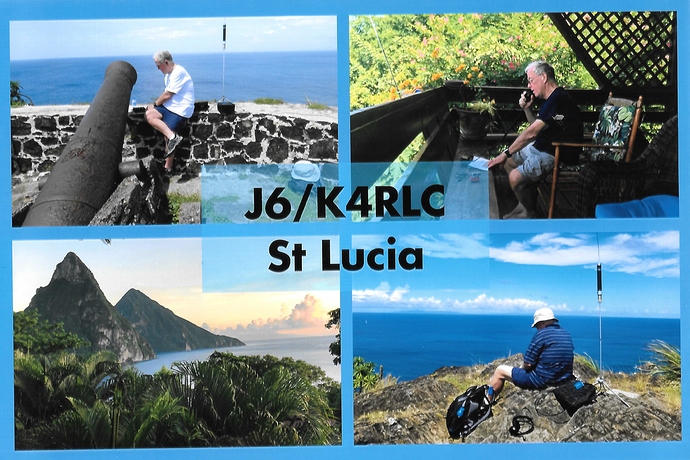I also made a shortened EFHW for 20m similar to Chris DL1CR’s. It is approximately 5m long but instead of x1, it has x2 loading coils equally spaced from each end (wound on toroids). It certainly matched OK on 20m. I can’t say I tried it on 10m. I will have a look for the design notes and post them.
I have worked intensively with the EFHW antennas. There are many variants with traps, in which only one or more coils are used without a capacitor.
The following example shows an EFHW that resonates on the 40m, 20m and 10m tapes without a tuner.
The coil performs three different functions.
If you operate the antenna at 40m, it serves as a classic extension coil for the shortened half-wave dipole.
It gets interesting at 20m. The wires connected to the end of the coil and the turns creates a small capacitance of approximately 4 pF. Together with the inductance of 34uH, they form a resonant trap for 14Mhz. Only the left part of the antenna wire acts as a half-wave antenna
At 10m, the coil becomes very high-resistance and has only a slight influence on the left wire, which is now a full wavelength.
The variant for 20m / 10m works in the same way
73 Chris
You may be interested in this one. I bought one for some experiments and wanted a lightweight pole. It is light with a very thin top section, only suitable for very light wires and I do mean light! Collapsed it is 64cms long which is just a few cms taller than my rucksack.
The only problem is that they must have bought a Chinese bargain tape measure off eBay and then ordered the tooling from a Chinese tooling company on Alibaba because their version of a metre is anything but a metre. Knowing this, I wanted an approx. 5m pole so bought their 6.3m and that is just a bit over 5m. Little tinkers. I wonder if a Chinese job wage is quoted as 10000 renminbi do you get paid 10000 or 8200 or some other quantity that’s short?
Anyway, they’re available and it came quite quickly from The Middle Kingdom. Though it was a lot cheaper when I ordered it last year pre-Covid.
EDIT: weighs about 310gm.
As promised, here is a sketch of the short vertical 20m dipole I made plus a diagram of the custom matching unit.
The overall height is 4.82m. The two loading coils are 15uH each.
I included a switch on the matching unit so that I could select between an attached counterpoise wire or use the short length of co-ax (shield) to the rig as a counterpoise. I found it works just fine using the latter (i.e. no separate counterpoise required).
I used this on a 6m pole with the top section removed. So, provided you can attach a 5 or 6m pole to a bench, you can have a half-sized 20m vertical dipole with only short run of co-ax to your rig.
The idea behind this was to keep the loading coils away from the centre where all the radiating current was and retain as much efficiency and lower angle radiation as possible.
It certainly worked with my FT-817 running 5W but I have not used it much (usually use full size antennas). However, I may give it another try as it is quite compact and easy to put up.
Many thanks - Did you have a link or photo with this?
This is great. Do you use the variable capacitor just to get the best SWR dependant on where you are set up?
Yes. So let’s try that again… https://www.ebay.co.uk/itm/2-7M-7-2M-Glass-Fiber-Spinning-Hand-Fishing-Rod-Telescopic-Stream-Pole/183536477004
You probably want to look at wire that is small and light. Probably Teflon insulated or maybe Kynar. If you are making anything other than a vertical so that it doesn’t drag the thin top over.
If you make that loaded shortened vertical for 20m, you should really make a 20m 1/4GP as a reference to compare it against. Or you wont know how much better/worse it is.
Yes, that’s right. Just adjust variable capacitor for minimum SWR. It has always matched OK on 20m regardless of location. Apologies for messy diagram. The variable capacitor knob is on the side of the enclosure.
The matching unit is on the bulky side. I used a larger air-spaced variable capacitor and a length of RG58U co-ax for the fixed 25pF capacitor to ensure a high voltage rating - with the aim of using it with 100W rigs as well as QRP. However, you could easily use a small ployvaricon type capacitor in place of both C1 and C2 to make a smaller QRP only matching unit.
A bit late to the discussion. I like to hike or pack to operate on exposed rock faces, eg, no place for a dipole or any type of wire antenna. My favorite band is 20 CW with the KX2. Last year, had good success from old volcanoes at St.Lucia, surrounded by salt water,
working QRP to the US, France, Germany, etc. with the MP1C (modestly known as the “Super Antenna.”I would like to improve the antenna performance. Will appreciate any suggestions for a vertical set-up, tripod mounted (no trees around), light enough for back packing or long hikes. (Weight of pack with radio, antenna, first aid kit, 2 Qts of H20, camera, etc was 20+ lbs). Tnx in advance, Bob K4RLC (will be at W4C/EM first week in July)
this is the pole I modified as above. Warning. It attracts hummingbirds ![]()
fred kt5x
I think you’ll find improvements are possible if you enhance the ground system, either by using several full size quarter wave radials, or by using multiple shorter radials where the full size radials are physically impossible.
If you don’t have radials, or have very short ones, like one metre long, the main earth system is the outer braid of the feed coax, the radio and the operator. To the extent that those conductors have some capacitive connection to the conductive ground, they are coupling to that ground and providing an earth system for the antenna. But they are not reliable, so replacing them with real conductors at the antenna base will improve it.
This approach would also improve the buddistick.
I have been searching for some descriptions of professional HF vertical antennas to see how professionals do it. WWV uses individual 1/4 wave verticals for each frequency used (2.5/20/25MHz with 2.5kW ERP and 5/10/15MHz with 10kW ERP). The description of each antennas comes from nist.gov so I’ll assume is reasonably accurate.
Each antenna is 1/2wavelength tall. The top 1/4 is the radiating element, the bottom 1/4 is isolated and used to raise the radiating element 1/4 wavelength above ground. There are 9 equal length radials, each of which slopes down at 45deg, each radial is sqrt(2)/4 wavelenth long. This is a little longer than the classic formula which suggests 1/4wavelength long (WWV length 0.3535 wavelength vs 0.25 wavelength). Antennas are fed with hardline coax and no coax crosses another coax feed.
This is what a professional service uses for a 1/4 omni antenna. It answers how high, how many radials, elevated or drooping on on the ground. Compared to amateurs, professionals will chose a location that meets their needs more that erect antennas in the location they have. Similarly cost is not really a problem relative to amateurs.
Now we’re not just amateurs but SOTA amateurs and we have a plethora of extra limitations on us that make using an antenna like that less suitable for SOTA. That design is going to get pretty damn unmanageable, heavy and a nightmare to setup very quickly for the more LF bands. But it’s good reference for what a professional chooses for an omni service.
So if you want to know how many radials you can get away with, or whether your loaded and shortened end-fed vertical or Buddistick is any good then make a reference and your intended SOTA antenna and run them using something like Richard CWI’s WSPR unit and see what others receive. Then you will have some numbers showing how they perform relative to what a professional uses.
When you have the numbers then you can then decide if the worse performance is acceptable to you for the relative ease of setup in a SOTA environment, weight, speed of band change etc. But you would have some kind of objective performance values to compare.
If you are looking for the collapsible pole in the US, but dont want to wait for Chinese shipments, here you go…
Kent K9EZ
This type of antenna, elevated feed point, half wave length, is similar to a Franklin antenna. A few broadcasters have used it with great success. There were stations in the Netherlands (1008, 747) that used it until they went off of the air.
Many of these types of antennas used 180* (half wave) on top and 120* on the bottom with ground radials to round it out. You could try a 90* (quarter wave) and 60* on the bottom with elevated radials. I bet that would play real nice.
The article attached has some of the best RF engineers ever commenting. Richard Fry (SK) and Kelly Alford (son of Andrew Alford - Creator of the first “Master” antenna on the Empire State Building - which still operates to this day) are some real heavy hitters when it comes to RF design.
Kent K9EZ
https://broadcastengineering.info/viewtopic.php?t=5675
Kent K9EZ
I bought as Wolf River Coils “SOTA Special” and used it for the first time with my MTB3 on my last SOTA outing in Colorado a few weeks ago. Although easy and fast to deploy, I found it lacking in performance. Probably due to low efficiency and the small 76" whip. I didn’t feel it was hearing as well or getting out as well as my 3-band linked dipole. As others have mentioned, it’s a bit finicky on the tuning and of course is quite heavy to haul up a mountain as compared to many alternatives. That said, I will go back to linked dipoles for SOTA, and use the WRC for POTA activations where I generally use a bit more power.
de Joe KE9AJ
What a shame they don’t acknowledge our trademark.
Hello Joe,
Is there any update on your use of WRC “SOTA Special”? I am curious as to how often you use it, did you have to make your own wire radials, etc? I have been looking into it, but I couldn’t find enough reviews on this “SOTA Special” antenna yet to make a judgment.
Thanks in advance,
Gokhan
seems to be a popular QRP kit tuner. I have friends who have built them. I have no personal experience but offer it as a possible option.
Hi Gents,
I have built a quick erect vertical from my scrap bin. It uses some 25 mm square plated steel for the base and a 5.5 m wire inside a fibre glass telescopic pole. Two 5.5 m on grass radials are used. To enhance 80 and 40 m signals I sometimes plug in a wire extension so the radiator length is 42 ft in total. That number was recommended by Ford Prefect. As he seemed to be a sensible chap I accepted his advice.
My set up and pull down time is half that for a doublet and the antenna is more inconspicuous. Park rangers with 27 MHz CB operations experience (older blokes) are comfortable with it. I have less concerns about people coming in contact with the radiator.
My AH705 matches this very well. I believe this arrangement is more efficient than Buddy Pole and similar antennas. It’s a lot less trouble
I do have less concerns about overfilling my log book. It does not work as well as a doublet at 7 m inverted Vee arrangement.
Verticals get a bad reputation for NVI contacts. That often isn’t bourne out in practice. There is ample radiation for contacts at 100 km and closer. Look at a radiation pattern for a vertical on the ground. It’s a lot different to an elevated vertical. Radiation at angles above 75 degrees is lost with present levels of ionisation.
Also with the wire extension there is more high angle radiation than I need.
No antenna is perfect so time spent agonising over what to use is better spent using something, anything, in the field.
73
Ron
VK3AFW
For some summits I have started using a Super Antenna (similar to the Buddy Pole). I find it useful on very rocky or very busy tops. In other situations I use either a linked dipole (20/40m) or linked wire verticals (one vertical/three radials - tuned to two bands. 20/10).
The SuperAntenna is definitely a compromise but works well in some situations and can be safer (compact, not such a trip hazard). I also like that it is multi band. There are two factors to make it consistently usable. I always use a chocked RG174 feedline and I use an elevated radial. A long length of wire on a kite winder, marked for the different bands. The SuperAntenna comes with a radial, that is four different lengths of wire that are laid out on the ground. In my experience in some situations it works well and in others not so well. The elevated wire is more constant. Whilst my radio (Xiegu G90) has an amazing tuner, I find I don’t have to use it, I check the SWR, tweak the antenna coil and go!
I hope that helps, Thanks Mark for your help!
73s Martin
Thanks for sharing your experience with this vertical HF. I have considered Super Antenna, but due to its pricey tag, haven’t taken any action. Here at Canadian Rockies, there are times summit is too small, no tree and windy. Only for these conditions, I have been considering obtaining a vertical HF. Otherwise, I have been happy and successful with my EFHW antennas.
Thanks
73 Gokhan



